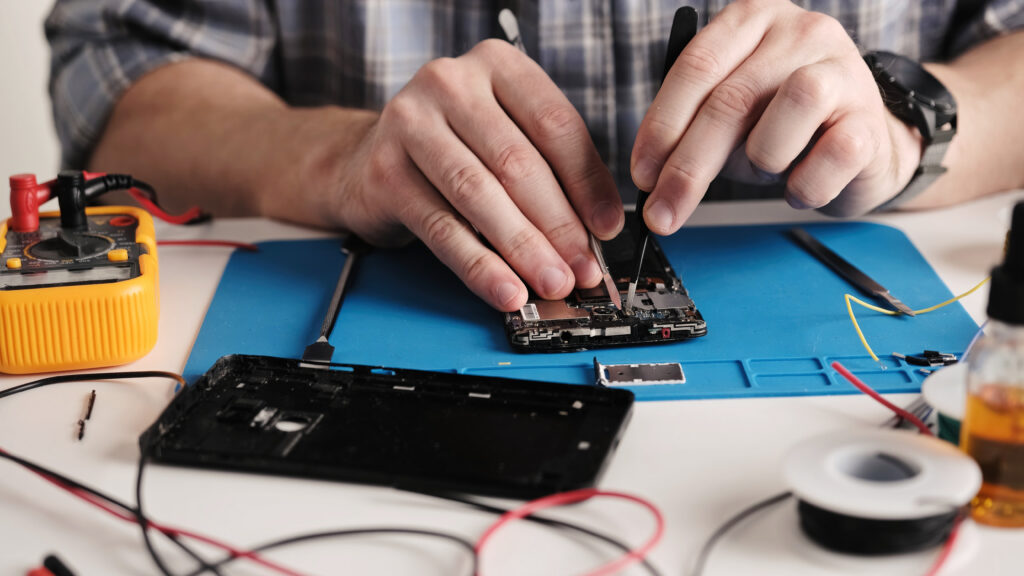By Laurie Mermet, The Invading Sea
When Florida Atlantic University student Curran Krapp tried to save money by buying used computer parts on Amazon, his thrifty plan backfired. After three rounds of faulty parts and a $100 diagnostic fee at Best Buy’s Geek Squad, he ended up spending $120 more than if he’d bought new components.
“I actually ended up spending more trying to save money,” said Krapp, who purchased seven computer parts, three of which he bought used. “Three parts were expensive so I tried to buy them (for) like $10 cheaper.” After multiple failed attempts with different sellers, he finally gave up on used parts altogether.
But while Krapp’s experience shows the risks of buying used electronics from unreliable sources, a new guide released by the Environment America Research & Policy Center aims to help consumers navigate the refurbished electronics market more successfully this holiday season.
The “Fixed for the Holidays” shopping guide provides advice on buying refurbished electronics, which can reduce environmental impact by up to 91% while offering significant savings over new items. The guide emphasizes the importance of choosing reputable vendors and checking warranty terms.
“We want to show the magic of refurbished gift-giving and give shoppers the know-how to spot a good deal,” said Mia McCormick, an advocate at Environment Florida, one of state-based environmental advocacy groups under Environment America. “It’s a win-win for the planet and consumers: create less waste, shop guilt-free and save money during the holiday season.”
Smart shopping strategies/tips

The guide recommends several trusted retailers for refurbished electronics. Back Market maintains high standards for its products and offers minimum one-year warranties with a 30-day return policy. Gazelle, which sources from users and mobile carriers, provides free standard shipping and extensive search functions. VIP Outlet specializes in returned items that are close to new, while Decluttr offers a 12-month warranty and special student discounts on media items.
Major manufacturers and retailers have also entered the refurbished market. Apple, Google and Samsung all offer certified pre-owned devices, though they tend to be more expensive than third-party options. Amazon’s marketplace provides a 90-day warranty minimum, while Best Buy’s Outlet program offers various categories of used products, from open-box to fully refurbished items.
What to watch out for
The guide warns consumers about several potential pitfalls. Shoppers should avoid products with outdated software support, fragile items like televisions and monitors, and used printers that may have built-up ink residue. Products with non-replaceable batteries, such as Apple’s AirPods, are particularly problematic as they’re designed to become obsolete when the battery dies.
“Terms such as ‘Like-New,’ ‘Open-Box,’ ‘Refurbished,’ or ‘Certified Pre-Owned’ can mean very different things at different places,” the guide cautions. Some vendors claim refurbishment after only wiping it clean and confirming the device powers on.
For smart shopping, consumers should expect discounts of 15-20% off new prices, plus an additional 10% discount per year since original sale. A three-year-old tablet, for example, might cost about half the price of its newest counterpart. The guide emphasizes the importance of thorough warranties – at least 90 days – and checking that refurbished items come with necessary accessories.
Environmental impact

The guide stresses that the environmental benefits of buying refurbished are substantial. Beyond reducing environmental impact by up to 91%, each refurbished device purchase prevents the extraction of 180 pounds of resources and the emission of 50 pounds of climate change pollutants.
The release comes as Environment Florida’s parent organization launches its “Designed to Last” campaign, pushing for repair scores similar to car fuel economy ratings that would help consumers judge product repairability before purchase
These scores, already available in other countries through retailers like Amazon, would rate products from 1 to 10 based on the availability of spare parts, how easy they are to disassemble and the durability of software support.
Success stories
The campaign has already seen some success, with Apple’s newest iPhone being its most repairable device yet. Right to Repair legislation is also making progress at both state and federal levels, expanding from consumer electronics to agricultural equipment and medical devices.
“It’s great to give gifts to loved ones or treat ourselves in the holiday season. We shouldn’t have to hurt our planet or our wallets to do that,” McCormick said.
The guide also provides practical tips for gift-giving, such as checking items thoroughly before gifting and planning for repackaging since refurbished items may not come in original boxes. It encourages consumers to consider donating their old electronics to nonprofits or finding reliable recycling centers when devices reach the end of their life.
However, as Krapp’s experience shows, the key is knowing where and how to shop smart.
“I think it was just the worst possible outcome, but I’m never going to do that again. I’m just going to buy the more expensive one,” he said.
Choosing trusted vendors and being familiar with warranty deals are tips that could save both money and frustration this holiday season.
Laurie Mermet is a Florida Atlantic University senior majoring in multimedia journalism who is reporting for The Invading Sea during the fall 2024 semester. Banner photo: Used electronics (iStock image).
Sign up for The Invading Sea newsletter by visiting here. To support The Invading Sea, click here to make a donation. If you are interested in submitting an opinion piece to The Invading Sea, email Editor Nathan Crabbe at ncrabbe@fau.edu.



